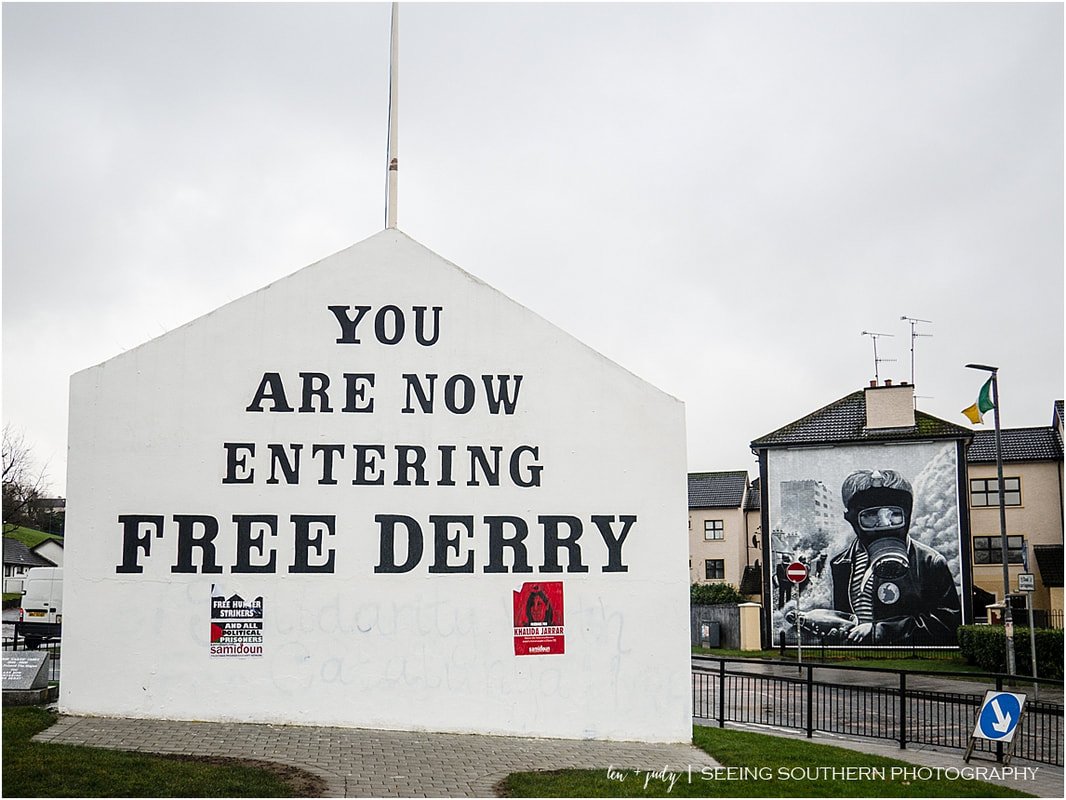Entering Free Derry | Londonderry
Walking among people mulling around the streets of Derry--or Londonderry as it is officially called—visitors find it difficult to believe that dissention, riots, and bombings were once the norm in this Northern Ireland city. A writer’s confession that until a decade ago, I, too, believed Northern Ireland was a volatile place; it was a place no one visited and few spoke of the area. Three years ago, I visited and became smitten with the people, the history, and the culture, and it’s the combination of all three elevate the city’s allure.
With most history, stories are complicated and characters, plentiful. As far back as the twelfth century, obstacles brewed with the Anglo-Norman invasion and the Brits. In the seventeenth century, a one-mile perimeter wall built around the city protected the citizens from England and Scotland. The nineteenth century brought the potato famine followed by world wars in the twentieth century. Fueled by everything that had come before, the Troubles erupted in 1968, a violent response to national independence from Protestants—those who wanted to remain part of the United Kingdom—and Catholics—those who wanted to leave the United Kingdom and form a united Ireland; it rattled the country for three decades.
Take a look at Derry/Londonderry’s history, but rest assured, this twenty-first century city is so much more than its past.
Begin the Derry/Londonderry experience at the Free Derry Corner at the intersections of Lecky Road, and Rossville and Fahan Streets. The massive black block phrase stacked on a white free-standing gable wall, You Are Now Entering Free Derry, was originally scrawled on a wall by an activist in 1969 during this all-to-real horror movie. From the gable wall down a 300-yard stretch, twelve murals shroud the ends of residential flats depicting clashes that played out over those 30 years. Across the street, a memorial to 14 young protesters who were slaughtered by British soldiers during Bloody Sunday, August 1972.
As an observer, this human document depicts harsh images, those of boys wearing gas masks to men carrying corpses. It’s intense, and it can’t help but move you as you walk down the street; The People’s Gallery (as it’s called) in the Bogside area serves as a remembrance of people seeking democratic rights. Private walking tours with Derry Guided Tours are available; however, if possible, book a tour with the artists themselves, The Bogside Artists.
While on the Bogside, visit The Museum of Free Derry. Every story ever born in the city is documented within the museum’s walls. As a visual reminder of Northern Ireland’s civil rights heritage, the museum explores the past and the future of a Free Derry. The museum is open daily.
From there, walk the 400-year-old city wall, erected in the seventeenth century and one of the last surviving in Europe. Inside the walls, the original city blueprint still showcases its Renaissance style. Information as well as tour information can be found at the Visitor Information Centre. Walk with the Martin McCrossan family of City Walking Tours for a comprehensive walk along the walls as well as other sites. At four euros, it’s the best deal in town.
As daunting as most of Derry/Londonderry’s history is, for many generations, their first introduction to the Troubles came via Netflix in the form of the hit show Derry Girls. Erin, along with friends Clare, Orla, Michelle and the “wee English fella James” share their 16-year-old lives during the Troubles of the 90s. For writer/creator Lisa McGee whose life mirrors the script, ordinary teenage behavior like skipping school, prom, and guzzling cheap vodka dominates the storyline of this group in convent school. Today, there are still some flashpoints of tension between Protestants and Catholics; ironically, telling history from a 16-year-old’s perspective to a twenty-first century world has, somehow, brought the city closer. On the side of Badger’s Bar in the city centre, when mural topics tend to push propaganda and civil unrest, the wall that faces Orchard Street is emblazoned with the cast of Derry Girls. Foul-mouthed, 20-foot Michelle flashes a peace sign while others display their famous smirks, drawing tourists and locals alike. Uncover the filming locations with a walking tour of all things Derry Girls.
While in the heart of the city, visit one of the most striking structures in Ireland, auburn-brick neo-gothic Guildhall. Originally built in 1887, it was destroyed twice; the existing one, which was completely restored in 2013, exhibits 23 stained glass windows showcasing the city’s story. Its clock rising above the city was fashioned after London’s Big Ben. Admission is free, and guided tours are available upon request.
From Guildhall, walk toward the river, and in only a few steps, approach the Peace Bridge (cycle and foot) which crosses the River Foyle. The river joins once-divided communities—the Protestant Waterside and the Nationalists Bogside—by a suspension bridge with two opposed and independent arms symbolizing a handshake across the river. Its existence has made a palpable change in people’s coming and goings; the bridge is never empty, and seats are provided at intervals for the quarter-mile round trip.
While across the bridge, take a break at Walled City Brewery, a family-run craft brewery that’s making its mark among the legendary Irish pubs in the city.. Enjoy Sunday Roast (literally) with slow roast meats and Yorkshire pudding; take a beer masterclass, tasting 10 brews and learning secrets; and if that whets your appetite, sign up for the Homebrew Academy, a one-day course that will have you concocting your own brew in no time. Open Wednesday through Sunday.
Get back to history, and end your Derry/Londonderry experience enjoying a traditional Irish pub. Its oldest, The River Inn, established 1684 when its license allowed them to sell punch, provide accommodations, and stable horses. Famous for live music from locals and visiting performers, head north a few blocks to Peadar O’Connell’s.
Pull up a chair and enjoy the afternoon at the cozy Grand Central Bar on Strand Street, a local favorite since 1922. A newer destination, Blackbird serves an exhaustive selection of Ireland’s craft beer. While most pubs are situated along the banks of the river and the heart of the city, you’re certain to happen upon the perfect spot for a pint.
No matter what you might have heard of a destination, it’s always important to make your own conclusions based on personal experience. Although its history is jaded, Derry/Londonderry’s resurgence as a vibrant historical and cultural city speaks to the tenacity of its people and a growing hope of rewriting its history going forward.











